Crankbait comprehension
Crankbait tricks for the nontroller
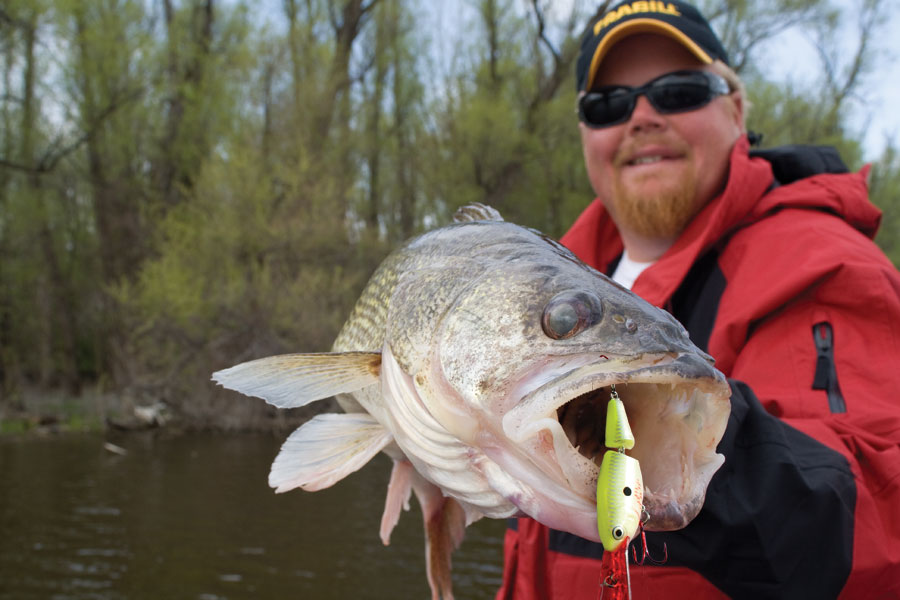
————————————–
Editor’s note: This is just one article from a recent issue of FLW Outdoors Magazine, which publishes both a Bass Edition and a Walleye Edition. To learn more about the magazine and how to subscribe, click here.
————————————–
The back of the package made it sound easy. All it said for instructions for your new crankbait was “dives 7 to 9 feet.” That seemed simple enough. Chuck it out, pull it back on a frozen rope, and the crankbait should attain the described depth, and presumably, bring a fish back with it.
Problem is it didn’t. You followed the one-sentence instruction manual to a tee. There must have been a typo because the crankbait didn’t get stuck in the teeth of a walleye. What gives?
Regrettably, the flaw lies in the fact that you went by the book, one that is far too short for the lure it covered. There is an incredible amount of technology built into crankbaits. However, there seems to be little operating information.
That’s where anglers like former Walmart FLW Walleye Tour pro Scott Glorvigen of Grand Rapids, Minn.; Captain Pat Kalmerton of Sheboygan, Wis.; and tour pro Brian “Bro” Brosdahl of Max, Minn., fill in the gaps. They take off-the-shelf crankbaits and turn them into dynamic presentations with split, even multiple personalities, and the versatility to perform and produce in multiple environments. In essence, they author the rest of the instruction manual. And for this exercise, they gave up Steps 1, 6 and 8, as well as Illustrations 1b, 6e, and everything in the Appendix (French, Spanish and Swahili not included).
A take from one of the twins
It seems like eons ago that Scott, one of the Glorvigen twins, brought home walleye fishing’s single-biggest helping of bacon. Hurling crankbaits into Green Bay’s Fox River, Glorvigen produced a three-fish limit on the final day of the inaugural Walmart FLW Walleye Tour Championship Presented by Berkley to capture a king’s ransom of $300,000.
Nearly a decade later, his passion for casting those fake but fabulous lures hasn’t waned.
“I love casting crankbaits, especially on rivers,” said Glorvigen, a co-founder of Gemini Sport Marketing, a business best known in fishing circles for producing sponsor-spattered tournament jerseys.
Glorvigen, like other river regulars, uses his trolling motor to stalk visible shoreline structure where the 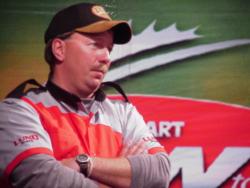 current is noticeably reduced, or “micro spots.” These 1- to 5-foot-deep alcoves might only hold a fish or two at any given time, but they are quick to recycle.
current is noticeably reduced, or “micro spots.” These 1- to 5-foot-deep alcoves might only hold a fish or two at any given time, but they are quick to recycle.
When one is located, Glorvigen casts upstream of the target, usually on a 45-degree angle, and lets the current pull his retrieve through the area. The casting angle will change depending on the current’s strength. Regardless, maintain the retrieve downstream a bit even after the lure has passed the money spot.
Amazingly, snags are few, but fish are aplenty.
“Fishing the right line is the key,” Glorvigen said. “When I think of casting crankbaits in rivers, it’s in water 5 feet deep or shallower. So the lure can’t dive too quickly. Otherwise, it will be in and out of the strike zone too fast, or worse, get hung up.”
On an Abu Garcia 700LX Series spinning reel, Glorvigen spools 10-pound-test Spiderwire Super Mono XXX. The low-stretch mono is ideal for this technique and casting crankbaits in general. While super lines will make the lure dive too fast, Super Mono keeps the lure up and still offers plenty of sensitivity.
For even better performance while cranking, Glorvigen likes to alter his reel.
“You never hear about roller guides on a spinning reel’s bail arm,” he said. “But their performance is important for casting crankbaits. If the guide isn’t spinning, the line twists, especially with crankbaits.”
Glorvigen loosens the factory settings so the guide actually rolls and the line doesn’t just slide over it. Only some of the more advanced reels feature moving roller guides.
His specialization doesn’t end there. Glorvigen, a slave to detail, ties directly to the lure’s split ring. Adding a snap or swivel increases the action, but it can also cause a tangle and lead to what Glorvigen calls a “dead quail” cast. Picture a game bird folding its wings after colliding with steel. That’s what a midair tangle looks like.
“If the lure tangles, you’ve wasted a cast,” he said. “That can translate into 20 or 30 missed opportunities in a day. And when rolling with the current you might miss the sweet spot.”
For this situation, Glorvigen knows the window of opportunity is brief, so he selects an intensely 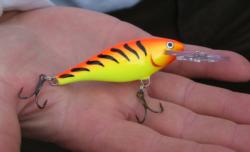 animated crankbait. Lately, his go-to lure is a Strike Pro Flex Phantom.
animated crankbait. Lately, his go-to lure is a Strike Pro Flex Phantom.
For general shallow river fishing, however, numerous floating, lipped, shad-style crankbaits are well-suited. Their shapes and sizes are familiar to river walleyes, and their actions can maneuver in the shallows. Other suitable choices include the time-tested No. 5 and No. 7 Rapala Shad Raps, Yo-Zuri Hardcore Shad, and Koppers LIVETARGET Shad and Perch. In slightly deeper water, consider the new SPRO MadEye Shad, which was developed with walleyes on the brain.
Why is it a good idea to use a floating crankbait?
“When a fish misses, and it will happen in dark, moving water, the lure pauses and begins to slowly rise, like a real minnow,” Glorvigen said. “There’s a good chance the fish will take another stab at it.”
Beyond that, floating crankbaits can be coaxed out of bottom snags. Pause on a limp line and oftentimes the lure, aided by swirling current, floats and frees itself.
Glorvigen’s prowess isn’t limited to rushing water. He gets cranky on open water as well, but approaches things in unique fashion.
“Casting in rivers is very spot specific,” he said. “In open water it’s more about coverage. I’m fan-casting and blanketing lots of water.”
Glorvigen modifies his equipment and techniques to accommodate the wide-open spaces. He starts with 10-pound-test Berkley FireLine to make the crankbait dive faster. However, for this technique he doesn’t tie directly to the crankbait. Instead, he fashions in a diminutive No. 13 barrel swivel, which leads to a 12-inch leader of 10-pound Berkley Vanish fluorocarbon. The fluorocarbon gives the setup a  little forgiveness, while disappearing from a walleye’s view. He’ll finish off the leader with a round-nose snap for the most wobble possible.
little forgiveness, while disappearing from a walleye’s view. He’ll finish off the leader with a round-nose snap for the most wobble possible.
This setup’s extra vibration is a winning ticket for Glorvigen when summoning walleyes from big structure and cover, like gravel bars, rock reefs and expansive weedbeds. Of course, there are also times when the heightened vibration simply catches more fish.
“My brother was beating me bad in a tournament at Devils Lake,” Glorvigen said. “We were throwing the same crankbait in the same areas, but he was beating me. It wasn’t until the final day of the tournament that he confessed he was using a snap. I was tying directly to the lure. The general consensus was that the extra wobble was what triggered the fish. It’s just like him to wait until the last day to share those minor details.”
Sheboygan’s version of Big Poppy
Casting crankbaits is an interpretive art. One man’s straight retrieve is another man’s herky-jerky theatrical performance. Kalmerton leans more toward the latter. The part owner of Wolf Pack Adventures outdoor guide service is a “pop fisherman,” demonstrating moves typically reserved for jigs.
“Bait doesn’t swim consistently, so you don’t want a consistent retrieve with a crankbait,” Kalmerton said.
With his rod and reel held high, about sternum height, he conducts the lure, integrating snaps, pauses and long pulls to create an energetic presentation.
“It’s all hands and elbows,” he said. “You’re constantly bumping the bottom, stopping and restarting, and always on a tight line. I want to feel everything.”
One of Kalmerton’s favorite techniques is strafing shallow rock reefs and points in late spring and early summer with this erratic technique. However, instead of launching lures inward, Kalmerton plops his behind on top of the structure and casts to the exterior.
“Active walleyes will be right along the break,” he said. “When you cast at steep structure from the outside, the crankbait is going to pull out and away from the rocks. When you do the opposite, casting from the inside out, the lure bulldogs right into the rock wall, bounces off and comes slamming back into it again. The bill will dig into the rocks. When it does, loosen up, let it float out and then bring it back barreling in again.”
The result is a “popping” action. Just remember to stay on your toes.
“By the end of the cast the lure is coming straight up, pushing lots of water and making a scene,” he said. “It’s not unusual to get bit right at the side of the boat.”
Such an unorthodox approach requires dedicated rigging. Kalmerton’s lures of choice are the Storm Original Thunderstick Jr. and Reef Runner Little Ripper. Both are hard-driving battering rams that appear on the walleye’s approved menu.
Kalmerton spools his baitcasting rod with 10-pound super line, which lets him feel the rocks and bottom. To that he affixes a small swivel, which opens to a 3-foot, 8-pound-test fluorocarbon leader for some spring for hard strikes.
If the structure is deeper than what the crankbait can reach – most of the aforementioned lures won’t reach 10 feet or more – Kalmerton adds lead to the line. Above, not below, the swivel on the main line he adds a 1/8- to 1/4-ounce fixed-position bullet-style weight, like a Northland Sling-Shot Worm Weight.
“I let the crankbait and weight drop awhile before starting the retrieve, experimenting until I find the perfect drop time,” he said.
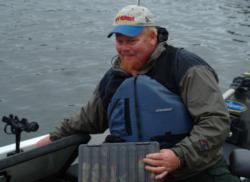 As a bonus, the supplemental weight also extends casting distance.
As a bonus, the supplemental weight also extends casting distance.
Bro on lures
Imagine that a crankbait is a humble maidservant. A swirl and tap of his rod and Brosdahl can turn a crankbait into Cinderella. If you’ve ever seen him in action, then you know he fishes with fairy godmother-like form and the magic to go along with it.
If Kalmerton is a “popper,” Brosdahl is a “twitcher and slasher.” To the casual observer the differences are subtle. To the fish they can be very consequential.
“Twitching is a cold-water pattern for times when walleyes need a chance to get up on the lure,” said Brosdahl, the third-place finisher at the 2009 tour event at Minnesota’s Leech Lake.
Before delving into the how, it’s sensible to discuss the where and what. Brosdahl twitches crankbaits around rocks, timber and other snaggy terrain in 3 to 8 feet of water – places where walleyes rely on ambush feeding tactics. But not all twitchers are created equal.
“The crankbait needs to be neutrally to near-neutrally buoyant, so when it stops, it suspends in animation or rises ever so slightly,” he said.
Brosdahl likes to use No. 8 and No. 10 Rapala Husky Jerks, and his twitching and spinning gear go hand-in-hand. He wraps 10-pound Berkley FireLine around his spool and finishes with a clear “shock leader” of 10-pound fluorocarbon tied to the main line via an improved clinch knot, with no swivel. He prefers the native action of the lure, but line twist is the price you pay for not using a swivel. Bro, however, has a solution.
“While motoring between spots, I’ll remove the crankbait and let 20 or 30 yards of line flow free behind the boat,” he said. “The line straightens right out.”
The wounded minnow action is imparted through Brosdahl’s retrieval cadence. With the rod tip at lake level, but without reeling, Brosdahl creates a twitch-twitch-pause retrieve and then reels in a few feet of line to reach a new audience.
“The lure will only dive a few feet, but that’s what I want,” he said. “Reactively, walleyes are drawn to the overhead action and silhouette. They’ll rise and strike. Even lazy fish in cold water can be coaxed.
“I want it to look like a jig – a jig packed with a mouthful of treble hooks.”
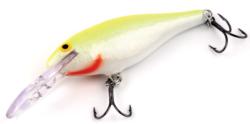 The antithesis of twitching is slashing. It’s best unleashed during the dog days of August, when walleyes will wallop fast-moving objects. Brosdahl slashes in the weeds, as well as in current, such as around wing dams, the commonality being that both zones are confined quarters that harbor big fish.
The antithesis of twitching is slashing. It’s best unleashed during the dog days of August, when walleyes will wallop fast-moving objects. Brosdahl slashes in the weeds, as well as in current, such as around wing dams, the commonality being that both zones are confined quarters that harbor big fish.
“These are small spaces,” Brosdahl said. “Casts must be accurate, and the lure needs to do its stuff right away.”
Pauses during a twitching sequence give curious fish a chance to catch up. Pauses during a slashing sequence occur as a byproduct of the vibrant retrieve. Using the rod, rip the lure forward in 2-foot bursts, reeling up slack in between before another hard rip. Each slash involves a redirect, too, as Brosdahl jerks stage right, then left, with his rod flaring just over the surface of the water. Strikes often occur as a pause morphs into the next rip.
While its main goal is to get walleyes to respond instinctively and eat the lure, slashing serves a secondary function when fishing leafy cover.
“It shreds the weeds,” Brosdahl said. “You get stuck and freed all at once. The commotion triggers fish, too.”
The Rapala X-Rap – not coincidentally dubbed a slashbait – fits Brosdahl’s technique like a glove, especially the No. 8 and No. 10 sizes. The fresh-off-the-shelf crankbait performs great around most cover, but Brosdahl will put on the surgical gloves if he’s pushing heavy cover.
“I make a few adjustments,” he said. “The simplest is bending the hook points slightly inward. Sometimes, especially if the weeds are really thick, I’ll remove the bottom treble hook altogether. A third adjustment is clipping off the bottom-facing barb on each of the trebles.”
With the sizes of packages shrinking by the year, I suppose it’s naive to expect better instructions. I am a realist, but that hint of idealist in me still daydreams about the day encyclopedias are packaged with crankbaits. Until then, I’ll keep calling Glorvigen, Kalmerton and Brosdahl.